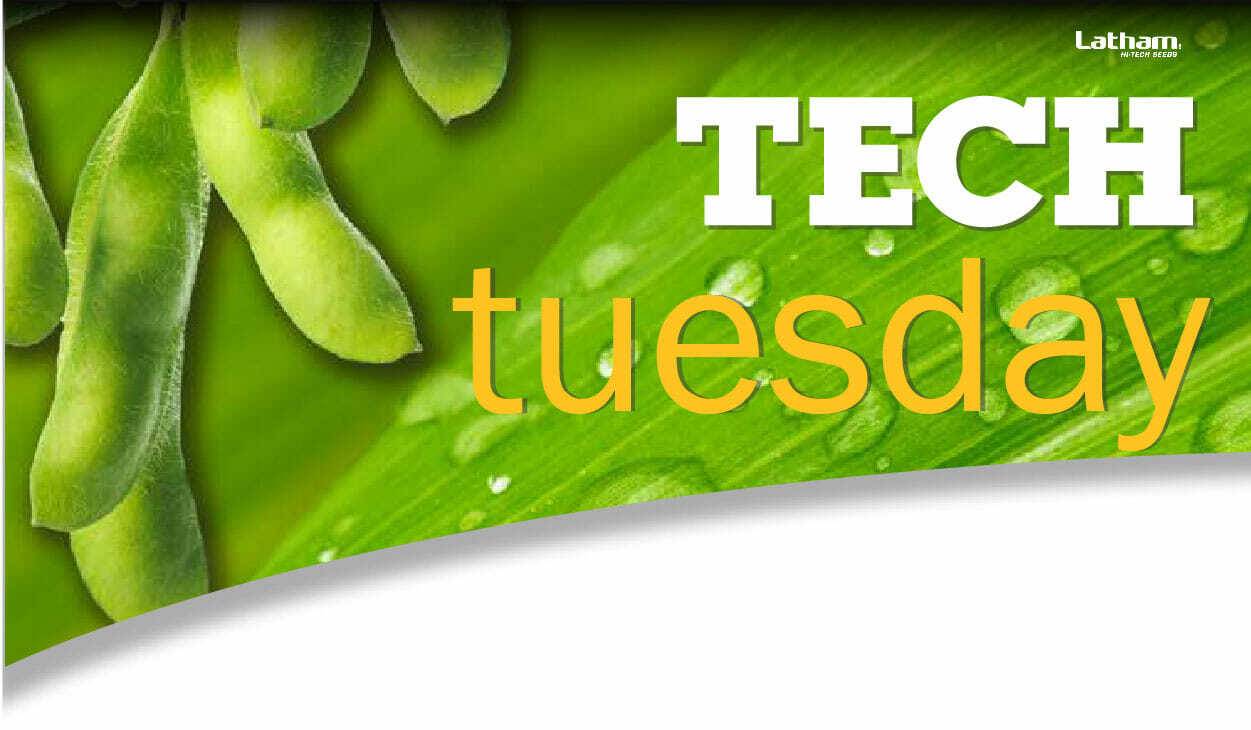Welcome back to our #AsktheAgronomist! John Latham & Kilah Hemesath talk Latham quality this morning. Quality has been the foundation of our company and still plays a vital role in our success.

Welcome back to our #AsktheAgronomist! John Latham & Kilah Hemesath talk Latham quality this morning. Quality has been the foundation of our company and still plays a vital role in our success.

Today we will be focusing on putting the information from our Bt trait options into practice and end with taking a look at the economics.
For the Facebook Live link, click here: https://www.facebook.com/LathamSeeds/videos/10156203873227138/

Risk reduction is one of the most critical considerations when designing your 2018 crop plan, as I’ve written in past articles.
While I tend to be a very early adapter to new products and technology, I also assess the risk versus the reward. Taking “calculated risk,” rather than reacting somewhat spontaneously to emotion-based marketing tactics that make us want to buy on the spot, is especially important in fragile markets.
“I think you should buy corn hybrids for silage only from seed companies that evaluate their hybrids for silage use,” writes livestock nutritionist Everett D. Thomas in an article published November 30, 2017, by Progressive Forage magazine. “… they should have silage yield and quality data, including fiber digestibility. In some seed company catalogs, corn silage is mentioned only in passing – or not at all.” Type this into your Internet browser to read this article in its entirety: bit.ly/2mE4az8
What a great statement! There are so many things to consider when planting a hybrid: consider the end use first; keep crop rotation in mind; and minimize risk factors.
From a plant genetics standpoint, top risk factors are moisture stress and disease pressure. Remember that healthy plants are needed in the field to produce high quality feed and top yield. The key is to strike that best balance between all critical factors, so what’s best in the field translates to what’s best in the bunk.
Latham’s FieldXFieldSM approach to crop selection helps put the best in each field, which is part of bringing the best in the bunk. Genetics certainly play a role in delivering quality at the bunk, but that’s only one factor of many when producing silage. You also need stress tolerance and disease management, which may include a fungicide, along with good plant nutrition, and a strong plan for timely harvest.
As an independent company, Latham Seeds has bountiful genetic options. Latham® Leafy products are a great corn silage-specific option. Sales of our leafy corn products continue to grow because they produce amazing tonnage and quality.
NOTE: Leafy and silage-specific products typically don’t score high in university trials, as leafy hybrids perform better at lower planting plant populations and university trials are geared for higher populations. If corn silage evaluation programs were planted at the lower populations and evaluated fairly, the results would be more reliable and comparable. Many corn silage growers like the flexibility they get with dual-purpose hybrids for their utility across varying soil types and flexibility at harvest time, and trait options. If the bunk is filled, growers can still get top grain yield and sell some grain.
Every grower’s needs and corn silage experience are unique and different. Silage-specific products don’t fit into some grower’s crop rotation based on the trait needed to reduce risk. The great news is that Latham has a full lineup of dual-purpose hybrids for those situations.
At Latham Hi‑Tech Seeds, we’d like to help you select the seed that’s best for your situation. We’ve collected lots of corn silage data, and multi-year data is available on www.LathamSeeds.com. And, feel free to also contact me at 1-877-GO-LATHAM or coreyc@lathamseeds.com.

Traited vs. Conventional corn, which is best for your operation? Tune in for a discussion with Phil & Kilah! https://www.facebook.com/LathamSeeds/videos/10156184246042138/

The precision ag world revolves around “variable rate” (VR) applications, which is typically where you unravel areas in fields where you can save input costs. Because we’re in our fourth year of low commodity prices, it’s a great time to see if variable rate seeding can increase your bottom line.
The first step is breaking you field into production zones, which should be managed differently based on their production potential. I’ve discussed the different data layers that can go into this decision, so I won’t cover it in this article.
The next step comes down to picking the right product and adjusting your seeding rates. Using Latham’s FieldXFieldSM service, we can determine the best hybrid for each situation. Choose a hybrid that will perform well on the majority of soil types in each field. If a field has uniform soils, then you need to use your historic knowledge of disease or other problems. Don’t pick a racehorse hybrid for a challenging field and wonder why it didn’t respond unless you plan on protecting it with a fungicide application, if necessary.
After you match the hybrid to your field, look at the ear flex noted in tables below the hybrids in our 2018 Product Guide. A Semi-Flex (SF) is usually your best option for a VR seeding application. If you’re looking at a Semi-Determinate (SD) hybrid, don’t count it out. All hybrids have some flex, but the SF will not give up as much yield in those lighter soils as the SD. A full Determinate ear would not be a good choice as it will give up the most yield if stressed by lighter soil conditions.
Be open to adjusting seeding rates more than 1,500 to 2,000 seeds per acre (spa). I normally like to see a swing of 3,000 to 4,000 spa when you’re trying VR seeding. Every soil type/hybrid combination has a different seeding rate sweet spot, so don’t expect to figure it out on your first try. When you pull the population down from 32,000 to 25,000 spa, plant spacing widens up another 2 inches and that dramatically changes the “competition” between plants. Suggested seeding rates can also be found in our product guide.
*Disclaimer: Seed placement and precision equipment are very important. You won’t see an advantage if your planter plants more doubles and skips than it does well-placed seed. When you lower populations on lighter soils, each corn plant needs enough space so it’s not crowded when it comes to its roots and canopy.
Variable rate seeding may provide that additional boost to your bottom line by bumping up yields in your top-yielding areas. Instead the focus is on lowering seed costs and maintaining yield on those areas that never seem to meet yield expectations. Experimenting on your farm is the best way to find an answer to this question. If you have the technology on your planter, make 2018 the year you give it a try! I’ll gladly help where I can, so feel free to give me a call.

Once you have it, you have it! Because sudden death syndrome (SDS) is caused by a soil-borne fungus, there’s no getting rid of it. Farmers must manage it to protect yield. Keep in mind that SDS was widespread in 2016, and many of those acres will be planted once again to soybeans in 2018.
The most promising tactic for SDS management is ILeVO® seed treatment. Numerous university trials have shown ILeVO effectively reduces SDS severity and protects yield. In addition, Latham’s own research confirms the findings.
With the help of many of Latham® soybean SuperStrip cooperators, our first company-wide trial using ILeVO was held in 2016. That year SDS was widespread, so many farmers across Latham Country lost significant yield to the disease. Our 26 plots showed an average yield benefit of about 3.5 bushels per acre.
This past growing season, however, SDS was not nearly as severe. Certain counties in Central and Eastern Iowa were impacted greatly by the disease but, in general, it was a season where SDS showed up late and didn’t cause as much lost yield.
We doubled the number of side-by-side plots from 2016 to 2017, and we added a few more varieties to the test. Results varied quite a bit by location due to disease severity and the soybean that was used in the study.
Following are a few observations based on the data gathered in 2017:
We plan to conduct another ILeVO trial in 2018. Feel free to contact me or your Latham RSM if you’re interested in being an ILeVO plot cooperator.

Phil Long talks about the what, why and how of variable rate seeding. For the Facebook Live conversation, click here: https://www.facebook.com/LathamSeeds/videos/10156143070902138/

One objective of Latham’s SuperStrip plot program is to help evaluate experimental seed products. Now that the 2017 harvest data has been analyzed, it’s my pleasure to introduce three soybean lines as mid-season releases for the 2017-2018 sales year.
These new soybeans come from our research on a new herbicide trait, the HPPD inhibitors, or Herbicide Group 27 compounds. The active ingredient being targeted is isoxaflutole, which is the base chemistry in several corn herbicides like Corvus® and Balance® Flexx.
You may have seen early announcements that the “Balance™ GT” soybean trait had cleared regulatory processes. It’s important to understand that as of press time, the EPA has NOT approved any isoxaflutole compounds to be sprayed over the top of soybeans. We are releasing these three cultivars as “GT” soybeans since they are cleared to be sprayed with glyphosate products only.
Remember to check LathamSeeds.com for 2017 yield data on these newly released soybeans!
L 2187 GT
2.1 Relative Maturity
Carries the Rps1-c gene for Phytophthora, as well as Soybean Cyst Nematode (SCN) tolerance from PI 88788.vIts ratings for Sudden Death Syndrome (SDS) and White Mold ratings are excellent, and its Iron Chlorosis score is very good. This line ranked in the top three in every trial in which it was entered during both 2015 and 2016!
L 2458 GT
2.4 Relative Maturity
Produces excellent yields across Iowa and into Illinois. It carries the K-gene for Phytophthora and strong tolerance to SCN from PI 88788. The Brown Stem Rot rating is excellent. It also has very good scores for White Mold, SDS and Iron Chlorosis. It has a very attractive tawny color at harvest and is also tolerant to the STS family of herbicides.
L 2638 GT
2.6 Relative Maturity
Carries the Rps1-k gene for Phytophthora and has strong tolerance to SCN from PI 88788. It’s a fairly bushy plant type that fills wider rows easily and has shown very consistent yields across all of Latham Country in 2015 and 2016 trials. Sudden Death, Brown Stem Rot, White Mold and Iron Chlorosis ratings are all very good to excellent.

Phil Long wraps up our Profitability Series! Tune in as he talks about seed traits, treatments and crop rotation. Have a great day!
For the Facebook live version, clicker here: https://www.facebook.com/LathamSeeds/videos/10156043160802138/

John Latham shares the TOP 5 Seed Stories of 2017 with us today! Tune in to see the year is review — seed industry style!